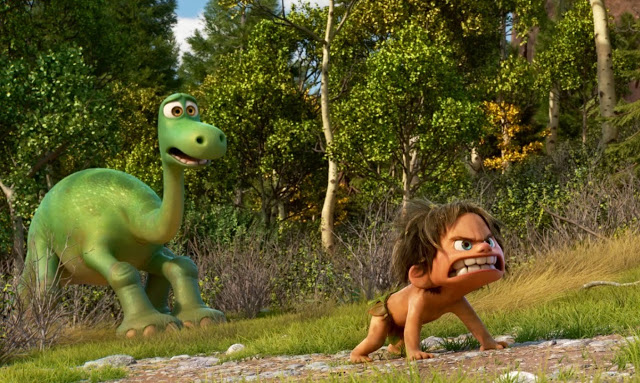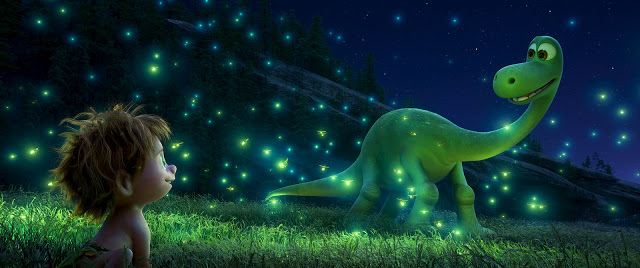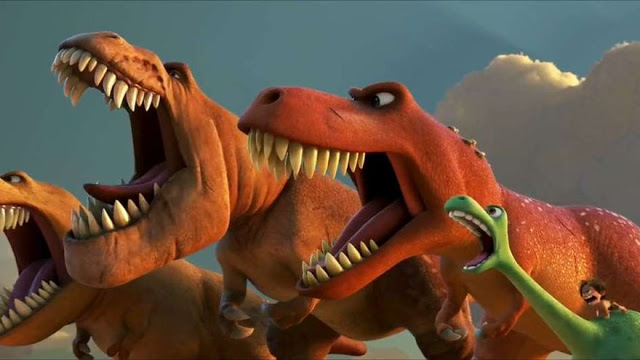To say that The Good Dinosaur is a mediocre Pixar movie is to praise it with faint damnation. For the past 20 years, the pioneers of computer-generated animation have been churning out imaginative, provocative entertainments on a regular basis, with nary a dud in the bunch; hell, the studio released a stunning masterpiece on the human condition just five months ago. So if you find yourself grumbling that this latest entry fails to climb to the extraordinary heights of Pixar’s (now owned by Disney) greatest films, remember that we grade these movies on a curve. An easygoing charmer, The Good Dinosaur may not be as transcendent as Wall-E or Finding Nemo—in fact, it doesn’t come close. But it remains a durable and intermittently astonishing work, with typically splendorous animation and an emotionally satisfying third act. Two decades ago, Toy Story rewrote the playbook on how animated movies can be made. The Good Dinosaur is less revolutionary—it plays by the rules—but its by-the-book approach has its own gentle appeal.
The film boasts a tantalizing premise that seems novel, until you realize it’s just window-dressing for a typical lost-boy narrative. It ponders a scenario, conveyed economically during a silent prologue, where the meteorite destined to wipe out the dinosaurs actually missed the Earth, resulting in a planet where giant lizards and humans coexist. That universe is rife with possibilities—one of which, sheer disaster, formed the backbone of the biggest-grossing movie of 2015—but the primary characters are essentially dinosaurs in name only. The hero is Arlo (voiced, in an irritating whine, by Raymond Ochoa), an anthropomorphized apatosaurus (think brontosaurus, but with a longer neck) and the runt of a family of mild-mannered herbivores. They live a peaceful farming life on a sun-dappled field that’s only a shade removed from Little House on the Prairie. Arlo’s father (Jeffrey Wright) is a stoic but warmhearted patriarch, while his mother (Frances McDormand) is a cliché of maternal kindness. Arlo himself is somewhat useless, too weak to perform hard labor and too fearful to stop small pests from harming the crops. Arlo’s perpetual petrifaction prevents him from “making his mark”, which, as his father tritely explains, involves planting a muddy footprint on the side of a corn silo.
That’s a clumsy coming-of-age metaphor made literal, and after its clever 30-second prologue, The Good Dinosaur‘s opening act sags with staleness and familiarity. Then again, its structural mundanity allows you to focus on the majestic visuals that are one of Pixar’s stocks in trade. (Even Cars 2, the only bad movie the studio has ever produced, looks phenomenal.) Arlo inhabits a world of quiet pictorial beauty—every grain of dirt seems to have been individually sculpted—but Arlo himself is the real jewel. With lime-green skin and a long, craning neck, he is constantly stretching to discover new wonders in this dazzlingly specific world, his flat white teeth snapping on juicy berries and scraggly branches. He also possesses a marvelous pair of soft brown eyes, which the animators (led by director Peter Sohn, filling in after Up co-director Bob Peterson got the boot) skillfully manipulate, allowing him to express every conceivable emotion. Arlo may be a talking dinosaur, but he says far more with his eyes than his mouth.
Fortunately, he spends a good deal of The Good Dinosaur with his yap shut. While the movie starts slowly, its pace picks up once Sohn and screenwriter Meg LeFauve (sharing a story credit with Peterson and two others) goose the narrative with some parental tragedy. It’s a predictable development—virtually every Disney film can double as a walking life insurance ad—but it gets your heart pumping, first with a startling moment of reflection, then with a roaring rapid that’s so stunningly rendered, it will have you clutching for the nearest life preserver. Terrible things happen in quick succession, and following some reckless bravado, Arlo tumbles down a cliffside and suddenly finds himself faced with an incredible journey. He’s homeward bound, and while he may be a dinosaur, he’s also a child: lost in the wilderness, unable to fend for himself, and entirely alone.
Well, not entirely. There is also Spot (Jack Bright), a feral caveboy who is prone to causing mayhem and who proves to be The Good Dinosaur‘s saving grace. An agent of chaos, Spot is indirectly responsible for that aforementioned tragedy, and Arlo initially views him as his natural nemesis. But Spot, with his maniacal energy and canny instincts, proves to be a savvy navigator of the wild, and he and Arlo strike up a tentative partnership, with Spot attempting to shepherd the hapless apatosaur back home.
In its bold strokes, The Good Dinosaur is a relatively rote adventure film, but its beating heart is the slow-developing relationship between Spot and Arlo, a trajectory that casts the two first as enemies, then allies, and then, finally, friends. It is in many ways an inversion of the typical boy-and-his-dog trope. Arlo may be an animal, but he’s humanoid and is often paralyzed with childlike terror; Spot, while technically a person, behaves more like a jackal, constantly running and growling but never actually speaking. But while they make an amusingly contradictory visual pair—where Arlo has smooth skin and moves with a steady lope, Spot sports an untamed mane of hair and routinely leaps from one obstacle to the next—they share feelings in common, most notably isolation and loss. (And also, at one point, delirium: After they consume some fermented berries, they suffer hallucinations, a bizarre development that is sure to draw complaints from overly sensitive parents.) Spot may not talk, but his iridescent green eyes are no less communicative than his comrade’s, and a scene in which he and Arlo silently diagram their family members, both living and dead, is a devastating piece of non-verbal storytelling.
That tender moment of contemplation is the apex of a movie that, while broadly conventional, doesn’t seem especially interested in the usual kid-friendly action scenes. Arlo meets a number of other dinosaurs on his travels: an eccentric styracosaurus (voiced by Sohn), a band of friendly tyrannosaurs (the leader speaks in the inimitable rumble of Sam Elliott), a trio of terrifying pterodactyls (including Steve Zahn). These creatures are all impressively designed, but their appearances feel like distractions from the main narrative rather than exciting developments. (By the same token, the 3-D is competent and non-invasive but unexceptional.) Arlo faces the expected hurdles that beset the hero of a children’s picture, and he defeats them through a familiar combination of guile and perseverance. But with the exception of a fierce battle between Spot and a neon-orange serpent, the louder moments in The Good Dinosaur lack real kick. As remarkable as this movie can be at times—particularly when the strained dialogue drops out and the characters’ fluid facial expressions take over, accompanied by the lilting score from Mychael and Jeff Danna—it can also feel frustratingly perfunctory.
And yet, despite its occasional listlessness, The Good Dinosaur is fundamentally satisfying, thanks largely to its focus on emotions above all else. Arlo and Spot may not engage in overly thrilling adventures, but their budding relationship is thrilling in its own way, resulting in a surprisingly powerful conclusion. Pixar has undoubtedly produced better movies, and The Good Dinosaur is not without its flaws. But it also confirms that the studio’s singular commitment to storytelling is far from extinct.
Jeremy Beck is the editor-in-chief of MovieManifesto. He watches more movies and television than he probably should.



